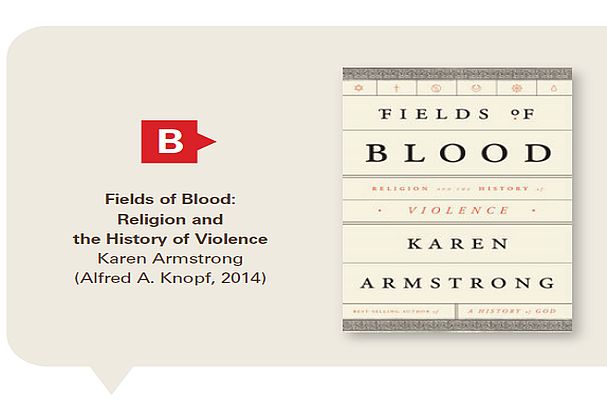A book review of
Fields of Blood:
Religion and the History of Violence
by Karen Armstrong
(Alfred A. Knopf, 2014)
This article first appeared in the Christian Research Journal, volume 38, number 2 (2015). For further information or to subscribe to the Christian Research Journal please click here.
Karen Armstrong, the well-known British author of such books as A History of God (Ballantine, 1993), The Case for God (Knopf, 2009), the strangely titled Muhammad: A Prophet for Our Time (Harper Collins, 2006), and other works, offers in Fields of Blood a comprehensive view of the role of religion in wars and violence from the beginning of civilization to the current day. She is an ex-nun, having spent seven years in a convent—but “a lousy nun,” as she once admitted in an interview, so she turned instead to research and writing. Yet, as the titles of her earlier books indicate, she never got far from God.
One might almost predict, then, that in this major volume she will rebel against her conservative Roman Catholic upbringing and blame religion in general, Christianity in particular, for the ugly violence that has always marred the human record from time immemorial. So many authors have gone that route, the too vocal Bart Ehrman as a recent example.
Surprise! Armstrong has not joined the raucous choruses of Bill Maher, Sam Harris, and other critics of the “lunacy of religion” in re-echoing the predictable plaint that “religion is the cause of all the hostilities of the past and present.” In Armstrong’s careful reading, blame aggressive nationalism and other political and economic factors instead. To be sure, religion was at times associated with war, but before modern secularism, religion was so conjoined with politics and nationalism—the real culprits— that society did not separate the two. It was all one whole in virtually all civilizations until the modern era. She then takes the reader on a world tour in space and time to support her thesis that the main root of violence was political and not religious.
Early Civilizations. She begins with the first cooperative communes that came together to farm, grow crops, and domesticate animals, providing mutual aid in these endeavors. There were the settled farmers but also the herders, who continued to live independently from settled communities. The farmers, when threatened by the herders (driving animals through their crops, killing—accidentally or intentionally—the residents of the communities and generally causing a serious threat to a community), selected a chief in a tribal setting. This grew to an inherited position of power, became regal, and then authoritarian. This leader, chief, king would gather warriors from the community to defend it or add territory to it. Thus the political and military root of civilization was born.
But even the earliest humans searched for and found meaning in their world, Armstrong continues. At the onset, they may have worshiped a river that provided the irrigation for their crops, fish for their diets, and water for drinking. As the river morphed into a symbol rather than the reality, the symbol was named and worship was directed to the symbol. As heroes were created from their protectors in the army, they too could become an object of worship. And, of course, the ruler, the chief, the king,who provided that army and protected his people, became an object of worship also. To organize this worship, priests arose as a new entity in the community. The common people provided their food and paid tithes to them for their service. Thus religion and the state were combined into one overarching authority.
The fragility of civilization was immediately apparent. It was a subsistence living, for the failure of one crop was an invitation to starvation. The kings, the priests, and their retainers demanded that the entire harvest be brought to them, and then they would parcel it out, first to themselves, then to those whose labor had produced it. The earliest settlements, about 5000 BC, were in plains between the Tigris and Euphrates rivers. These early farmers developed irrigation systems and cooperatively worked to chart and then dig the canals and ditches.
The author, having begun in these same plains, describes wars from the time of Gilgamesh, all done for defense or territorial expansion rather than religion. She covers China, the Hebrews, Islam, and India, showing that they all began as agrarian societies and developed with leadership, army, priest, peasant class delineation in parallel fashion, though with minor adjustments.
The Crusades and the Reformation. But the Reformation and the entry of industry and banking caused a shift in these arrangements. Absolute monarchies could establish and control strong trade, but the equation begins to differ, in that individuals, not royalty, could enter into business. The Crusades, for example, required massive amounts of money for the Europeans, and their bankers were the Knights Templar, among others.
While Armstrong agrees that the Crusades, as the name implies, were more religious in nature at the start, conflicts in trade and fiscal issues were quickly involved, and they were a good way to employ the armies in Europe to fight someone other than their own monarchs. The Middle East was not only the home of the religious sites that the Crusaders were ostensibly there to liberate but also a major trade center. The Islamic rulers who took these areas were inhibiting trade. Even in the violence of the very religious Spanish Inquisition, Armstrong argues, the real object was to rid Spain of Jews, who were competitive money lenders of repute, and not so much religion.
The Thirty Years War that decimated the populations of France, the German states, and everyone in between is supposedly the great example of a religious war. And yet its terrible violence became less sectarian as the years rolled on, and finally became a political duel between the Habsburgs and the Bourbons, with Swedish Lutherans and French Catholics as allies in its final phase.
Modern and Current Conflicts. Ever since the Enlightenment of the eighteenth century, Europe became progressively secularized, and religion played less and less a role in government, society, and especially war. The revolutions across the world were secular, as were the Crimean War, the Franco- Prussian War, World War I, World War II, and beyond. The hostilities were totally political, nationalistic, even chauvinistic. There were Protestants, Catholics, and Jews on both sides of the wars. In Armstrong’s view, the sin of the secular nation was and is the inability to tolerate minorities. Thus, countries where people of all stripes had lived together for centuries tried to rid themselves of those who were different. Nationality becomes the new “religion,” as it has in the Middle East, where a variety of ethnicities had lived together and now cannot. Thus in Germany in the 1930s and ‘40s, Hitler wanted to purge the entire nation of all ethnic groups that his henchmen declared not Aryan, such as the Gypsies, the Jews, and others who were deemed inferior, not because of their faith but because of their ethnicity.
Are we any better today? No, or there would not be continuing conflict in the Middle East or in our own neighbor – hoods and cities. The violence in society has not been “caused” by religion but by greed—the need for acquisition of land, riches, and power. Religion is not the cause of violence, but greed and a sense of entitlement certainly is. The Middle East was carved up by the French and British after World War I, not on religious lines but for access to economic boons. That carving is the basis for present-day terrorism.
A Concluding Critique. While Karen Armstrong has made a noble effort in absolving religion of the false general notion that “religion has caused all the wars”—for it certainly has not—she errs in not having a more objective approach to history, a failure that has compelled her to do endless “explaining away” of those many, many instances where religion was most certainly and centrally involved. The following wars, for example, were caused primarily by religious partisanship: the Jewish War with Rome; the wars of Muslim expansion in the Middle East, Africa, and Europe; the First Crusade; the First Phase of the Thirty Years War; and others, leading up to the current war against ISIS and Islamic extremism everywhere.
But the subtitle of this book claims that it is about the history of violence. There, alas, we have much greater religious involvement. One of the worst examples of religious violence in all of history is what happened to the English Protestant martyrs before the reign of Queen Elizabeth. Has Armstrong ever read Foxe’s Book of Martyrs? Hardly any of these victims had any political involvement, and yet they were horribly tortured and burned to death as heretics by the religious authorities. Unfortunately, there are many examples of religious violence, ranging from Jews versus Muslims in the Middle East, Catholics versus Protestants in Ireland, Muslims versus Hindus in Pakistan and India, Sunnis versus Shia, as well as extremist bombings and mayhem by Muslim terrorists across the world.
Armstrong, unfortunately, seems to share the “political correctness” of the Eastern liberal establishment in the United States that tries every way possible not to mention “Islam” in connection with terrorism and the obvious religious motivation of the suicide bombers of 9/11 and since, as well as all the violent atrocities currently taking place. None of this can be explained away as caused by political or economic factors, despite the author’s best efforts. The Taliban and ISIS are not inspired in their cruelty because politicians years ago drew wrong borders in the Middle East but by the “sword” passages in the Qur’an. Armstrong sidesteps these, just as did the Islamic Council of New York after 9/11, by citing the peace passages in the Qur’an. Then, lest anyone point out the contradictions in that holy book, she quickly adds that the Old and New Testaments do the same thing. That is not a good response: there are no “sword” passages in the New Testament, and Jews and Christians obedient to the teachings of Scripture don’t blow up places of worship or anything else.
As a Christian, I am truly embarrassed and totally disgusted by the true role of religion in the history of violence. I only wish Armstrong were right. Unfortunately, the plain facts of the past are against her. —Paul L. Maier
Paul L. Maier is professor emeritus of ancient history at Western Michigan University, and a much-published author, whose latest book is The Constantine Codex (Tyndale House, 2011).









